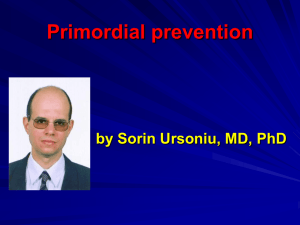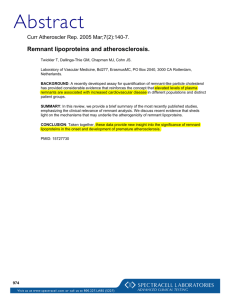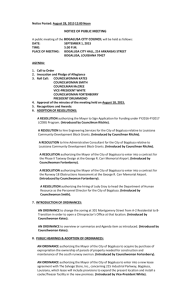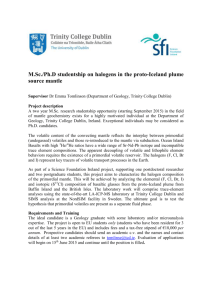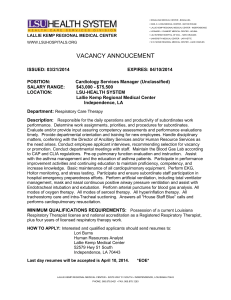Primordial Prevention – A Perspective from the Bogalusa Heart Study
advertisement
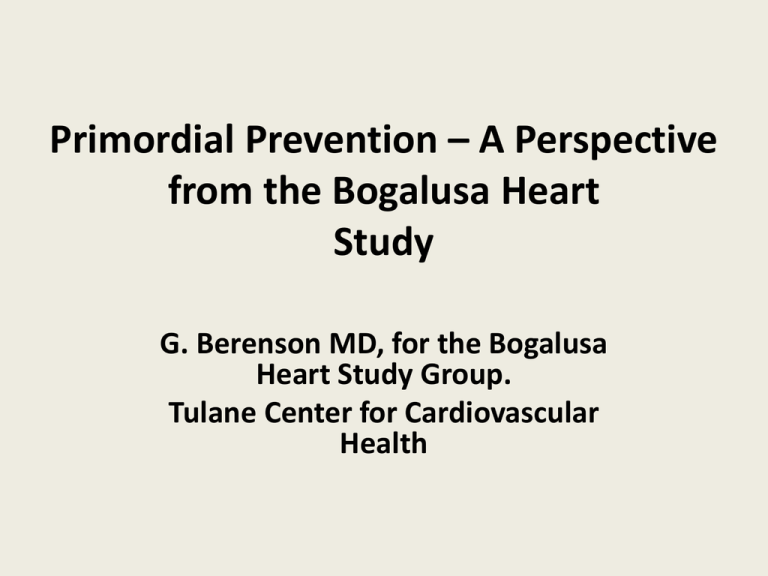
Primordial Prevention – A Perspective from the Bogalusa Heart Study G. Berenson MD, for the Bogalusa Heart Study Group. Tulane Center for Cardiovascular Health Primordial Prevention • There is about to be a revolution in cardiovascular health care, better an evolution to one with emphasis on prevention in early life. Until now, emphasis has been on secondary prevention of patients with known CV disease, coronary artery disease and hypertensive cardiac and renal disease. Yet, primary prevention of individuals prior to a clinical presentation of cardiac events has long been of interest with the landmark VA hypertension study (1) by Fries and the Multicenter Coronary Drug Project (2). Secondary prevention • The emphasis on secondary prevention has been sparked by advances from the pharmaceutical industry, particularly with the development of statin drugs, as an outgrowth of the Nobel Prize to Goldstein and Brown. Equally so, are tremendous advances with the development of antihypertensive agents. But, it is only recent that I have heard the concept of Primordial Prevention being advocated. This entails the prevention of the occurrence of CV risk factors, as pioneered by the Framingham study. William Kannel came up with the term in the early years of Framingham, and they have stuck. Concept of Primordial Prevention • The Concept was suggested by Tom Strasser from the World Health Organization (3) , in terms of prevention strategy. This is a logical approach, since Geoffrey Rose raised the issue of risk in terms of “sick individuals vs sick populations” (4) . I participated in two WHO and two American Health Foundation symposia , the latter held by Ernst Wynder, and all indicated the need to address risk factors in early life (5). For me, it was these meetings that gelled the concept of primordial prevention, enunciated by Strasser. History of Primordial Prevention • The consideration of primordial prevention is the essence of population studies at the level of children , that now go back almost 40 years. The Muscatine study was begun by Bill Connor who originally suggested to me to “Pick a Community”, rather than a hospital- based population, after our original grant application, based on a population of children enrolled in a psychology study at the Big Charity Hospital in New Orleans, was turned down by NHLBI as an award for a Specialized Centers of Research – Arteriosclerosis (SCORA). This rejection was a lucky break. To begin studies on children did not seem out of the ordinary even 40 years ago. History of Primordial Prevention (2) • Our Department of Pathology, headed by Russell Holman and his crew Henry McGill, Jack Strong, Bill Newman and Richard Tracy, pointed out the occurrence of atherosclerotic lesions in early life , even in infants as young as three years of age (6). Holman´s disciples later helped form the multicenter, superb Pathologic Determinants of Atherosclerosis in Youth (PDAY), with Bob Wissler from the University of Chicago (7). Background to begin studies in children • Autopsy studies of soldiers in the Korean War and later in the Vietnamese war showing such a high prevalence of coronary atherosclerosis set the stage to encourage Congress to fund NHLBI to promote SCOR´s in four areas: arteriosclerosis, hypertension, pulmonary and blood diseases. We finally got one for arteriosclerosis focusing on the community of Bogalusa. • These observations in Pathology, the much earlier emphasis on cholesterol in arterial wall plaques by Anitskow, the analytical ultracentrifuge studies by Gofman(8) and electrophoretic studies of lipoproteins in terms of atherosclerosis by Frederickson(9), provided the background to begin studies in children. Our previous studies • Our own studies of acid mucopolysaccharides (glycosaminoglycans) and proteoglycans of the arterial wall even studied aortas from 12‐20 year olds in an attempt to separate the process of early atherosclerosis from the changes in older individuals. We even provided some insight into the factors producing atherosclerosis (10). In our laboratory SR Srinivasan, studying acid mucopolysaccharides complexing with serum lipoproteins, led us to the development of a method to quantitate the serum lipoproteins in small amounts of serum. This method by Srinivasan gave us the opportunity to do studies of risk factors. We began by advocating their study in medical students, our precious commodity in an academic environment (11). The jump to children and Bogalusa began when support for a SCOR‐A was funded. Bogalusa Heart Study • The beginning of the Bogalusa Heart Study was mentored by CA McMahon who insisted on us writing and adhering to protocols. This became very obvious with the need for long term and secular trend studies, that were to come. He also emphasized quality controls by blind duplicates of blood samples that tested the total process of collection through data analysis, training the team as a whole, not a nurse or observer individually, in order not to compress the data. He stressed not to “contaminate the population or data” by preliminary studies. Obviously, the usual randomization and duplication procedures were followed . CA McMahon’ Role • His mission, as he stated, was to see we “collect reliable data”. His insistence on these principles and telling us we did not know how to measure blood pressure and having us work and train one year in Franklinton, 20 miles from Bogalusa, made a difference in our study. Such diligence got us in “trouble”. Our first set of blood pressure data was 15 mmHg lower than that of the first Pediatric Task Force. We promoted 4th phase diastolic pressure until adult stature is reached and we noted a linear relation of blood pressure to height. Such observations are still neglected even though four Pediatric task force reports have occurred. Similarly, with the availability of publications on the Internet in the mid 1980´s , other findings related to risk factors in children are ignored. The aim of the Bogalusa Heart Study was to study and determine risk factors as defined in adults and apply to children. We came up with four questions: • What are the risk factors in children and how to define abnormal ones? • What is the interrelation of risk factors? • Do risk factors persist over time and predict adult levels? • And what are the genetic and metabolic characteristics of young individuals with high or low levels? (12,13) Basis for primordial prevention • Basically, after we screened over 4000 children, spanning an age of birth to 17 years, our goal was really to understand the early onset (a natural history) of atherosclerosis, hypertension and even target organ changes, and type II diabetes mellitus. Our publications now attest to the fact that all of these adult diseases begin in childhood and can be diagnosed in childhood, at least with some limitations, long before CV –renal events occur in adulthood. Herein lies the basis for primordial prevention. Fundings • There are several observation most germane to the Bogalusa Heart Study. The autopsy studies were probably the most critical and these set the later stage for the more elegant PDAY studies. Blacks have higher blood pressure, more progressive CV disease, myocardial, vascular and renal; white women have a lag in developing coronary disease; a greater development of coronary artery disease occurs in younger white men; and there are a host of hemodynamic, metabolic, and fluid and electrolyte racial and gender contrasts. Most important what occurs in childhood is predictive of findings in adulthood. Conclusion • Primordial prevention will have to recognize the fundamental observations from pediatric population studies, namely Bogalusa, Muscatine, Finland and others. Twenty years ago we were funded to develop and demonstrate prevention based on the findings from Bogalusa. The most successful has been the development of a comprehensive health education program (K‐6 Health Ahead/Heart Smart) that addresses the entire school environment. Strongly behavioral oriented, it successfully achieves a control of obesity, improves healthy life styles, and promotes healthy decision making, beginning at least by Kindergarten. It addresses both risk factors and equally, social problems. Conclusion (2) • The program also provides attention to role models, teachers, and parents (14). Many splintered trials and programs are now beginning to address health and prevention in children, but most are single focused, like obesity, or exercise, or smoking. These need to change in order to address the total health of children and incorporating education and learning to deal with the toxic environment in which we live. To us, early and broad health education and health promotion are the beginning of primordial prevention. References • 1. Veterans Administration Cooperative Study on Antihypertensive agents (1970): Effects Of treatment on morbility in hypertension II. Results in patients with diastolic blood pressure 90 through 114 mmHg. JAMA, 213:1143‐1152 • 2. Canner PL, Berge KG, Wenger NK et al (1986). Fifteen year mortality in Coronary Drug Project patients: long‐term benefit with niacin. JACC; 8: 1245‐55. • 3. WHO Expert Committee (1990). Prevention in childhood and youth of adult cardiovascular diseases: Time for action. Geneva, Switzerland WHO: Tech Report Series 792 References (2) • 8. Gofman, J.W., Lindgren, R.T., Elliot, H.A., Mantz, W., and Hewitt, B. (1950): The role of lipids and lipoproteins in atherosclerosis . Science, 111:166‐171 • 9. Frederickson, D.S., Levy, R.I., and Lees, R.S. (1967): Fat transport in lipoproteins: An integrated approach to mechanism and disorders. N. Engl. J. Med, 276: 148‐156 • 10. Berenson GS, Radhakrishnamurthy B, Srinivasan SR, Vijayagopal P, Dalferes ER Jr (1988): Arterial wall injury and preteoglycan changes in atherosclerosis. Arch Pathol Lab Med 112:: 1002‐1010
